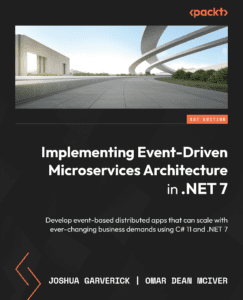Josh Garverick is the author of Implementing Event-driven Microservices Architecture in .NET 7; we got the chance to sit down and find out more about his experience of writing with Packt.
Q: What are your specialist tech areas?
Josh: Microsoft Azure, Azure DevOps/GitHub, Developer tools, C#.
Q: How did you become an author for Packt? Tell us about your journey. What was your motivation for writing this book?
Josh: I had published a couple of online courses with Packt and was approached about writing this book. I pursued it mainly to help further knowledge of the topic in the community, but also because I wanted to learn and experiment more with it.
Q: What kind of research did you do, and how long did you spend researching before beginning the book?
Josh: Most of the research I conducted consisted of trying out technologies, reading articles, and discussing with colleagues of mine who are experts in developing event-driven systems. I spent roughly about 6-8 weeks researching and discussing.
Q: Did you face any challenges during the writing process? How did you overcome them?
Josh: The main challenge I faced was balancing burnout between getting chapters completed and increasing demands from my day job. In some cases, I requested a bit of time off to help clear my mind. I worked extensively with the team at Packt to help manage and reset expectations where needed. Everyone was more than accommodating.
Q: What’s your take on the technologies discussed in the book? Where do you see these technologies heading in the future?
Josh: I think streaming platforms such as Kafka are going to be a staple for a couple of years at least, just due to how well they can handle high transaction volumes and provide near-time processing if needed. I can see gRPC outpacing HTTP(S) due to performance and adoption levels in the community. I can see managed Kubernetes offerings becoming more intelligent and potentially self-managing with engineers needing to worry about just their application components.
Q: Why should readers choose this book over others already on the market? How would you differentiate your book from its competition?
Josh: This book gives not only great examples of how the patterns and technologies are implemented, but also gives you the ability to see how those are applied within a larger system.
Q: What are the key takeaways you want readers to come away with from the book?
Josh: As with any technological endeavor, there are usually more items that impact (and are impacted by) the way components and systems interact. Understanding the technology as well as how technology enables the business will benefit you in the long run.
Q. What advice would you give to readers learning tech? Do you have any top tips?
Josh: Don’t let things like Kubernetes overwhelm you (it is not easy when starting out). Not every problem can or should be solved by containers. Look for examples or tutorials that play to how you learn best–some people like instructional videos, while others prefer step-by-step interactive tutorials.
Q. Do you have a blog that readers can follow?
Josh: Not at the moment.
Q: Can you share any blogs, websites, and forums to help readers gain a holistic view of the tech they are learning? What are the key takeaways you want readers to come away with from the book?
Josh: Three big sites would be the Azure Architecture Center, the Apache Kafka site, and Microsoft Learn.
Q. How would you describe your author’s journey with Packt? Would you recommend Packt to aspiring authors?
Josh: Yes, the team has been more than supportive in providing feedback on my work as well as working with me when my day job’s demands became greater than my ability to write.
Q. Do you belong to any tech community groups?
Josh: Microsoft Most Valuable Professional (MVP)
Q. What are your favorite tech journals? How do you keep yourself up to date on tech?
Josh: It’s difficult to keep up with changes, especially with how often functionality changes. I tend to use Twitter to help find key items promoted by my favorite engineers, and I subscribe to the Azure Weekly newsletter by Endjin.
Q. How did you organize, plan, and prioritize your work and write the book?
Josh: I worked sequentially as much as possible and started by using the outline to stub out sections and subsections of each chapter. I would then go through and fill out the subsections, trying to set goals for myself for completing certain content.
Q. What is that one writing tip that you found most crucial and would like to share with aspiring authors?
Josh: Don’t give up–work with your publishing team if you hit writer’s block, burnout, or have other events come up that impact you.
Q. Would you like to share your social handles? If so, please share.
You can find Josh’s book on Amazon by following this link: Please click here










